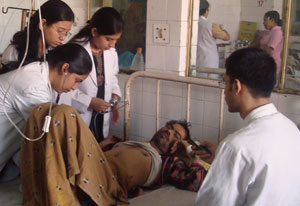Fogarty-funded scientists help clarify dengue risk
May / June 2013 | Volume 12, Issue 3

Photo by Gautam Pandey/Photoshare
Fogarty-funded researchers revealed the dengue
virus is more prevalent than previously thought, with
nearly half of the world’s population at risk for
contracting this potentially lethal infection.
The threat to human health from the mosquito-transmitted dengue virus is much worse than previously thought and improved surveillance is an essential part of tackling its spread and impact, according to a new study by an international team of researchers partly funded by Fogarty.
Dengue fever, a sometimes disabling or deadly disease, occurs at least three times more frequently than previously estimated, researchers said in their Nature paper, recently published online. They put the infection number at 390 million cases annually, versus the WHO's estimate of 50-100 million. Having a clear handle on the risk is important for policymakers and scientists tackling the disease, which the WHO describes as fast emerging and pandemic-prone.
The researchers incorporated more data than previous investigations. They analyzed dengue diagnoses records, constructed a model to map the global distribution of risk and included longitudinal information from dengue cohort studies and adjusted population census data.
Although the bulk of dengue infections go unnoticed, hosts still serve as reservoirs and can help spread the disease, so the researchers included all cases of dengue that disrupted daily routine, rather than only treatment-seeking cases.
The study yielded a global infection estimate of 96 million in 2010. Asia accounted for 70 percent - with about 34 percent of those in India - and Africa and the Americas each had about 15 percent.
"Our approach provides new evidence to help maximize the value and cost-effectiveness of surveillance efforts," the researchers wrote in their report. "Knowledge of the geographical distribution and burden of dengue is essential for understanding its contribution to global morbidity and mortality burdens, in determining how to allocate optimally the limited resources available for dengue control and in evaluating the impact of such activities internationally."
Dengue's main vector is the striped Aedes mosquito, particularly Aedes aegypti. The insects are difficult to control - feeding during the daytime, breeding in very small quantities of water and thriving with today's climate disturbance, rising urbanization and growing human populations. "We predict dengue to be ubiquitous throughout the tropics, with local spatial variations in risk influenced strongly by rainfall, temperature and the degree of urbanization," the authors noted in their report.
Along with more frequent infection comes a higher threat of serious illness - dengue hemorrhagic fever or dengue shock syndrome. This is because the virus has an unusual impact on the human immune system. Four versions exist and although humans develop lifelong immunity to the initial virus, subsequent infection by another type can disrupt the immune system reaction and make serious disease more likely. Scientists don't understand exactly why.
Currently, no therapeutics or vaccines exist and mosquito control measures have failed to rein in dengue's spread. Researchers are stepping up efforts to find interventions, including vaccines, treatments and mosquito control, and in the meantime are determining effective ways to handle any outbreaks.
The study was supported by the International Research Consortium on Dengue Risk Assessment, Management and Surveillance, the Wellcome Trust, U.S. Department of Homeland Security, Li Ka Shing Foundation and Fogarty.
More Information
To view Adobe PDF files,
download current, free accessible plug-ins from Adobe's website.